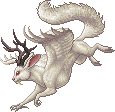



General
Though superficially similar to jackalopes, these curious tree-dwellers lead very different lifestyles and are thought to be unrelated to the horned rabbits. Wolpertingers are only found in the northern reaches of Silva Forest where they can occasionally be spotted jumping from tree to tree. They spend most of their time in high pines and fir trees, rarely coming to the ground unless absolutely necessary. Their bodies are very squirrel-like and it is easy to mistake them for squirrels as the run along branches. Wolpertingers tend to be unusually colorful for forest mammals, and it is thought that the brightness of their plumage and pelage is an indicator of an animal's overall health. Their feathers and the antlers are both involved in mate selection by female wolpertingers. Males have larger antlers than females, which they use during their rut to fight off competitors from their designated territory.
Egg
This egg chitters occasionally.
Hatchling
Wolpertingers hatch blind and hairless in messy dreys of leaves and twigs hidden high in the treetops. Despite their relative helplessness, they are born with sharp claws and clinging feet that help them stay in the trees even if they manage to fall out of their nests. After a few weeks, they are ready to explore their homes under the watchful supervision of their mother. Litters usually contain four or five pups, though only one or two usually makes it to adulthood. The hatchlings are unable to fly or jump long distances until they are several months old, at which point they have reached their full size and are chased off by their mother to find their own territory.
Adult
Wolpertingers are well-suited for the cold northern reaches of Silva. They do not hibernate, instead grouping together with neighboring wolpertingers in tree hollows to stay warm during the coldest parts of the year and relying on caches of food stored during the summer and fall. They are omnivorous and eat nearly anything they can find, though seeds and acorns make up the bulk of their diet. They take most of their food from trees before it falls to the ground, and are able to eat young seeds and cones that have not ripened yet, giving them an advantage over other forest-dwellers that feed on similar foods. Despite their agility and speed in the treetops, wolpertingers have many predators, and are favorite prey of martelus and santule marska. Though wolpertingers are frequently able to escape marska if they detect them soon enough, martelus are deadly predators with a nearly eighty percent capture rate. One of the only times wolpertingers will go to the forest floor is to flee from a martelus, as they are slightly faster than their predators on flat ground.
Notes
Obtained from: Breeding
Breeding: Yes
Renaming cost: 200 gold
Release date: March 27th 2018
Element: Neutral 
Breeds with the following:
Albino Wolpertinger + Albino Wolpertinger = Albino Wolpertinger (Normal)
Albino Wolpertinger + Albino Wolpertinger = Wolpertinger (Very hard)
Wolpertinger + Albino Wolpertinger = Wolpertinger (Normal)
Wolpertinger + Albino Wolpertinger = Albino Wolpertinger (Normal)
Obtained by breeding any of the following pairs:
Wolpertinger and Wolpertinger (Normal)
Sprite art: Mysfytt | Description: PKGriffin